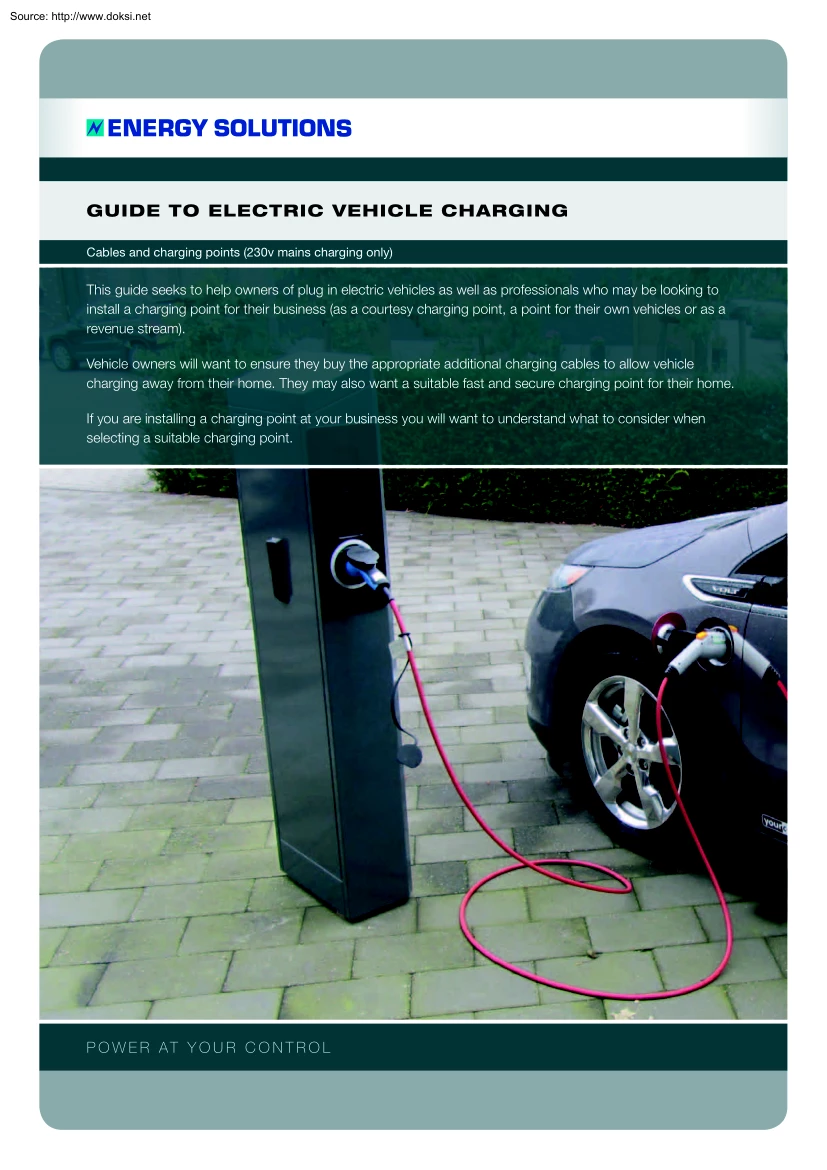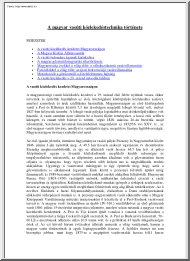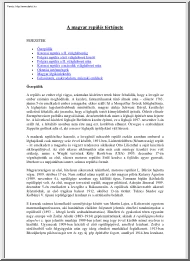Datasheet
Year, pagecount:2012, 4 page(s)
Language:English
Downloads:5
Uploaded:October 28, 2019
Size:1 MB
Institution:
-
Comments:
Attachment:-
Download in PDF:Please log in!
Comments
No comments yet. You can be the first!Most popular documents in this category
Content extract
Source: http://www.doksinet GUIDE TO ELECTRIC VEHICLE CHARGING Cables and charging points (230v mains charging only) This guide seeks to help owners of plug in electric vehicles as well as professionals who may be looking to install a charging point for their business (as a courtesy charging point, a point for their own vehicles or as a revenue stream). Vehicle owners will want to ensure they buy the appropriate additional charging cables to allow vehicle charging away from their home. They may also want a suitable fast and secure charging point for their home If you are installing a charging point at your business you will want to understand what to consider when selecting a suitable charging point. P O W E R AT Y O U R C O N T R O L Source: http://www.doksinet THE CAR SIDE Electric vehicles and plug in hybrids have an in-built battery charger that allows them to recharge the vehicle battery from a normal mains supply. The vehicle will have an inlet for a charging cable. It
would be great if they were all the same – but they are not! Two types exist: Type 1 Inlet and plug Type 2 Inlet and plug Type 1 Inlet Type 2 Inlet The Type 1 inlet is an American / Japanese standard. Whilst the plug has a latch, to prevent the plug falling out of the socket, it does not have a lock. This means that anyone can unplug the car end of your charging cable. The Type 2 inlet is a European standard (IEC 62196). The plug has no latch, but the car has a locking pin that locks the plug in place. This means that only the car owner can unplug the car end of your charging cable. The plug has pins to carry power and a safety ground and a further two pins for communication. Note: The same Type 2 connector can (as is) used at the other end of charging cables to plug into commercial, and some domestic, charging points. Within the plug there are two resistors that allow the car to detect: 1. That a cable is plugged in 2. If the lever to unlatch the plug is being pressed.
This simple communication allows the car to know that a cable is connected (so it can start communicating with a charging point) and also to turn off its charger if the latch is pressed so that it is not drawing power when you unplug the lead from the car. Most vehicles at this time (early 2012) use this type of connector as most vehicles have Japanese or US technology. The plug has pins to carry power and a safety ground and a further two pins for communication. The pin arrangement allows for different types of mains power to be connected to the vehicle (3 phase as well as single phase). Within the plug there are resistors that allow the car to detect that a cable is plugged in and a second resistor that allows the car to detect how much power the cable can carry. This means that you can carry a lighter cable and still plug it into a high power charging point. The charging point will tell the car its capacity and the cable will indicate how much power it can carry. The car charger
will then ensure that it works to the lowest capacity component in the system. Summary Hopefully the information above is of interest and helps explain how the systems work. However, as a car owner you have what you have! As a charging point provider you are also unaffected – your only concern is what to provide at the other end of the cable. Contact our EV team: 01634 290772 sales@energy-solutions.couk Get more info: www.energy-solutionscouk Buy online: wwwes-storecouk 2 | ES - Guide to EV charging Source: http://www.doksinet THE CHARGING POINT SIDE For the scope of this document we are talking about charging with single phase only. To help put the information into context we have detailed the most likely supplies that will be available: 13A Domestic Socket Mode 3 charging point Domestic socket These are rated at 13 amps in the UK. However most high power equipment that plugs into domestic sockets works for limited periods only (kettle, toaster, hairdryer etc). Because of
this all cars will only draw 10 amps from a standard domestic outlet (or any outlet that does not offer some means of communication to the car to tell it otherwise). 10 amps is approximately 2.3 Kw of power A normal mains outlet offers no locking facility. This means that (if you have a Type 1 car connector) that your cable is vulnerable to theft. Because these types of outlets do not have the communication necessary to enable charging on a mass produced electric car they require a Mode 2 cable that has the communication electronics in an in-line box in the cable. Mode 3 charging point This is exactly the same connector as the car Type 2. It has the same locking pin arrangement. A type 2 outlet can supply up to 32 amps (7.2 Kw), but does not need to be rated for this. As most cars can only use 16 amps (3.6 Kw) these charging points are usually rated at 16 amps A type 2 charging point is quite clever! It will only turn on its power if both ends of the cable are connected. Before
turning on the power it locks the charging point end of the cable in place with a pin (making it theft proof) and only then applies power to the cable. It also communicates with the car with an active signal (low voltage PWM) to indicate the available power from the charging point (10 amps, 16 amps or any other value as appropriate). The car will then decide if the cable can handle the available power from the charging point and draw the lesser of the values. Once the car is fully charged the car communicates this status to the charging point and the charging point turns off the power (but leaves the cable locked in place). The locking and unlocking of the cable can be achieved with a simple push button (OK for secure environments), a magnetic card (which can be given to a staff member or lent to a hotel or business guest) or can be a contactless payment card that also is connected to a ‘back office’ system that takes money from the car owners credit card. Summary A Mode 3
charging point is needed for fast charging. Contact our EV team: 01634 290772 sales@energy-solutions.couk Get more info: www.energy-solutionscouk Buy online: wwwes-storecouk ES - Guide to EV Charging | 3 Source: http://www.doksinet CHARGING MODES We have covered the types of connectors on the car and the charging point. You would think that this was it – but there is more! The charging Mode sounds more complex than it is. There are 4 charging Modes Modes 1-3 are for charging from a mains connection using the in car battery charger. We will look in more detail at these Mode 4 is a ultra-fast charge using an external battery charger. The Mode of charging is independent of the connectors. It is all about the communication between the car and the charging point. Mode 1 Mode 3 This is the simplest type of charging and generally only used by home built or converted electric vehicles. Mode 3 charging is from a ‘smart’ charging point. The passive capacity information from the
cable is enhanced with active communications between the charging point and the car. This communication includes charging point capacity and the ability for the car to instruct the charging point to turn off the power when the car is fully charged. It requires no communication - just the correct plugs. Mode 2 charging cable Mode 2 This is a bit of a cheat for cars that do not support Mode 1 charging - which is all mass produced electric vehicles. This is likely to be the default lead that comes with your car. This communication gives you a really big advantage – the possibility of faster charging. The car will now use 16 amps (more if the inbuilt charger can use it and the cable / charging point can handle it). If it takes 10 hours to charge with Mode 1 or 2 (10 amps) your charge time will be reduced to 6 ¼ hours if you use a 16 amp Mode 3 charge point. Get the right charging point and cable for your car If you have a car that requires a Mode 3 charging you will be unable to
charge from a 13 amp plug (at home, work, friends house etc) - you can only use a clever Mode 3 charging point. We have easy to follow guides, by car. You can select in just a couple of clicks the charging points & cables that are right for your EV. Mode 2 charging gets around this problem by using an in-line box of electronics in the middle of the charging cable. This box emulates the communication of a clever charging point and allows the cable (instead of the charging point) to communicate with the car. Download at: www.energy-solutionscouk Contact our EV team: 01634 290772 sales@energy-solutions.couk Get more info: www.energy-solutionscouk Buy online: wwwes-storecouk 4 | ES - Guide to EV charging
would be great if they were all the same – but they are not! Two types exist: Type 1 Inlet and plug Type 2 Inlet and plug Type 1 Inlet Type 2 Inlet The Type 1 inlet is an American / Japanese standard. Whilst the plug has a latch, to prevent the plug falling out of the socket, it does not have a lock. This means that anyone can unplug the car end of your charging cable. The Type 2 inlet is a European standard (IEC 62196). The plug has no latch, but the car has a locking pin that locks the plug in place. This means that only the car owner can unplug the car end of your charging cable. The plug has pins to carry power and a safety ground and a further two pins for communication. Note: The same Type 2 connector can (as is) used at the other end of charging cables to plug into commercial, and some domestic, charging points. Within the plug there are two resistors that allow the car to detect: 1. That a cable is plugged in 2. If the lever to unlatch the plug is being pressed.
This simple communication allows the car to know that a cable is connected (so it can start communicating with a charging point) and also to turn off its charger if the latch is pressed so that it is not drawing power when you unplug the lead from the car. Most vehicles at this time (early 2012) use this type of connector as most vehicles have Japanese or US technology. The plug has pins to carry power and a safety ground and a further two pins for communication. The pin arrangement allows for different types of mains power to be connected to the vehicle (3 phase as well as single phase). Within the plug there are resistors that allow the car to detect that a cable is plugged in and a second resistor that allows the car to detect how much power the cable can carry. This means that you can carry a lighter cable and still plug it into a high power charging point. The charging point will tell the car its capacity and the cable will indicate how much power it can carry. The car charger
will then ensure that it works to the lowest capacity component in the system. Summary Hopefully the information above is of interest and helps explain how the systems work. However, as a car owner you have what you have! As a charging point provider you are also unaffected – your only concern is what to provide at the other end of the cable. Contact our EV team: 01634 290772 sales@energy-solutions.couk Get more info: www.energy-solutionscouk Buy online: wwwes-storecouk 2 | ES - Guide to EV charging Source: http://www.doksinet THE CHARGING POINT SIDE For the scope of this document we are talking about charging with single phase only. To help put the information into context we have detailed the most likely supplies that will be available: 13A Domestic Socket Mode 3 charging point Domestic socket These are rated at 13 amps in the UK. However most high power equipment that plugs into domestic sockets works for limited periods only (kettle, toaster, hairdryer etc). Because of
this all cars will only draw 10 amps from a standard domestic outlet (or any outlet that does not offer some means of communication to the car to tell it otherwise). 10 amps is approximately 2.3 Kw of power A normal mains outlet offers no locking facility. This means that (if you have a Type 1 car connector) that your cable is vulnerable to theft. Because these types of outlets do not have the communication necessary to enable charging on a mass produced electric car they require a Mode 2 cable that has the communication electronics in an in-line box in the cable. Mode 3 charging point This is exactly the same connector as the car Type 2. It has the same locking pin arrangement. A type 2 outlet can supply up to 32 amps (7.2 Kw), but does not need to be rated for this. As most cars can only use 16 amps (3.6 Kw) these charging points are usually rated at 16 amps A type 2 charging point is quite clever! It will only turn on its power if both ends of the cable are connected. Before
turning on the power it locks the charging point end of the cable in place with a pin (making it theft proof) and only then applies power to the cable. It also communicates with the car with an active signal (low voltage PWM) to indicate the available power from the charging point (10 amps, 16 amps or any other value as appropriate). The car will then decide if the cable can handle the available power from the charging point and draw the lesser of the values. Once the car is fully charged the car communicates this status to the charging point and the charging point turns off the power (but leaves the cable locked in place). The locking and unlocking of the cable can be achieved with a simple push button (OK for secure environments), a magnetic card (which can be given to a staff member or lent to a hotel or business guest) or can be a contactless payment card that also is connected to a ‘back office’ system that takes money from the car owners credit card. Summary A Mode 3
charging point is needed for fast charging. Contact our EV team: 01634 290772 sales@energy-solutions.couk Get more info: www.energy-solutionscouk Buy online: wwwes-storecouk ES - Guide to EV Charging | 3 Source: http://www.doksinet CHARGING MODES We have covered the types of connectors on the car and the charging point. You would think that this was it – but there is more! The charging Mode sounds more complex than it is. There are 4 charging Modes Modes 1-3 are for charging from a mains connection using the in car battery charger. We will look in more detail at these Mode 4 is a ultra-fast charge using an external battery charger. The Mode of charging is independent of the connectors. It is all about the communication between the car and the charging point. Mode 1 Mode 3 This is the simplest type of charging and generally only used by home built or converted electric vehicles. Mode 3 charging is from a ‘smart’ charging point. The passive capacity information from the
cable is enhanced with active communications between the charging point and the car. This communication includes charging point capacity and the ability for the car to instruct the charging point to turn off the power when the car is fully charged. It requires no communication - just the correct plugs. Mode 2 charging cable Mode 2 This is a bit of a cheat for cars that do not support Mode 1 charging - which is all mass produced electric vehicles. This is likely to be the default lead that comes with your car. This communication gives you a really big advantage – the possibility of faster charging. The car will now use 16 amps (more if the inbuilt charger can use it and the cable / charging point can handle it). If it takes 10 hours to charge with Mode 1 or 2 (10 amps) your charge time will be reduced to 6 ¼ hours if you use a 16 amp Mode 3 charge point. Get the right charging point and cable for your car If you have a car that requires a Mode 3 charging you will be unable to
charge from a 13 amp plug (at home, work, friends house etc) - you can only use a clever Mode 3 charging point. We have easy to follow guides, by car. You can select in just a couple of clicks the charging points & cables that are right for your EV. Mode 2 charging gets around this problem by using an in-line box of electronics in the middle of the charging cable. This box emulates the communication of a clever charging point and allows the cable (instead of the charging point) to communicate with the car. Download at: www.energy-solutionscouk Contact our EV team: 01634 290772 sales@energy-solutions.couk Get more info: www.energy-solutionscouk Buy online: wwwes-storecouk 4 | ES - Guide to EV charging





